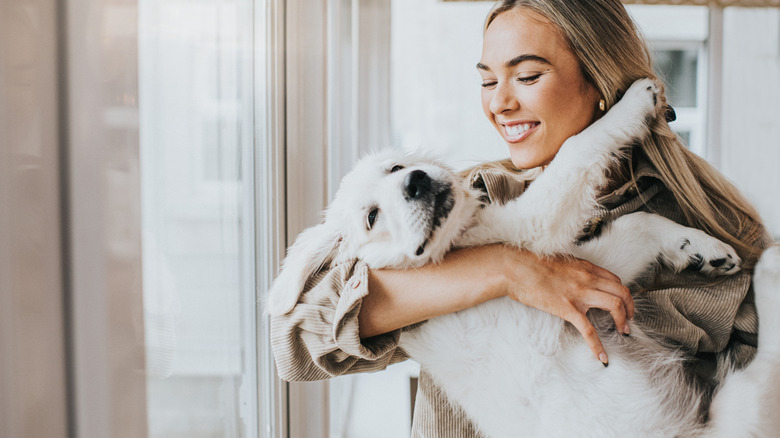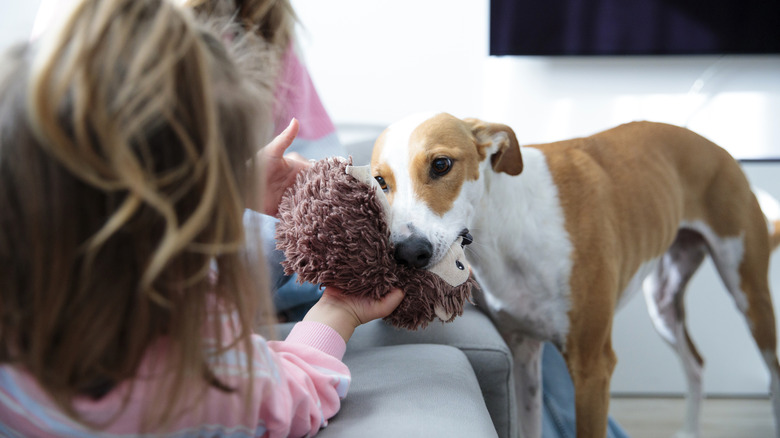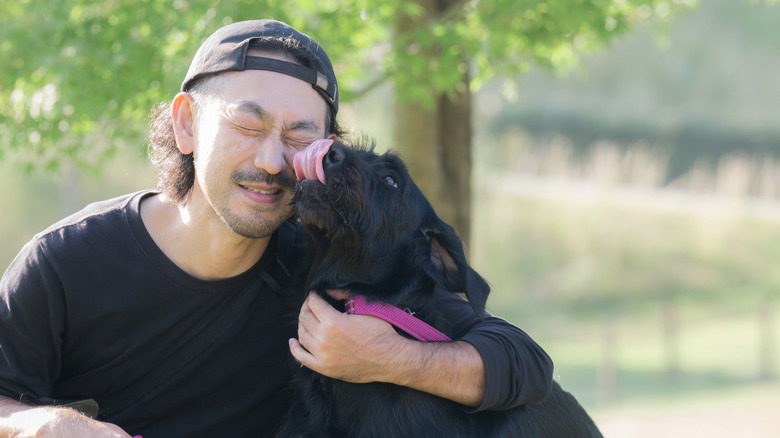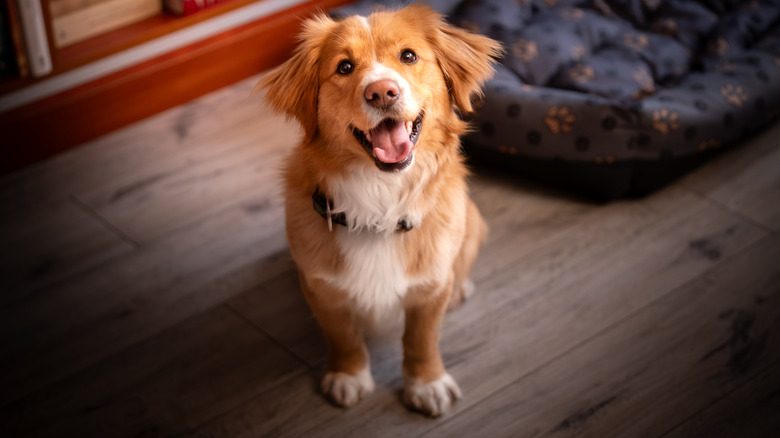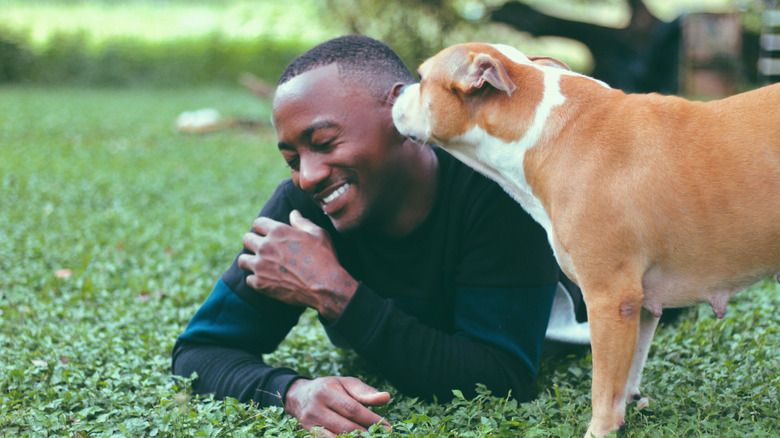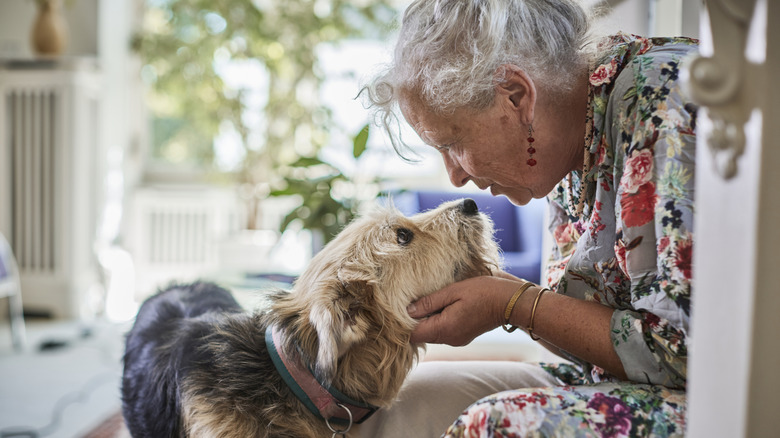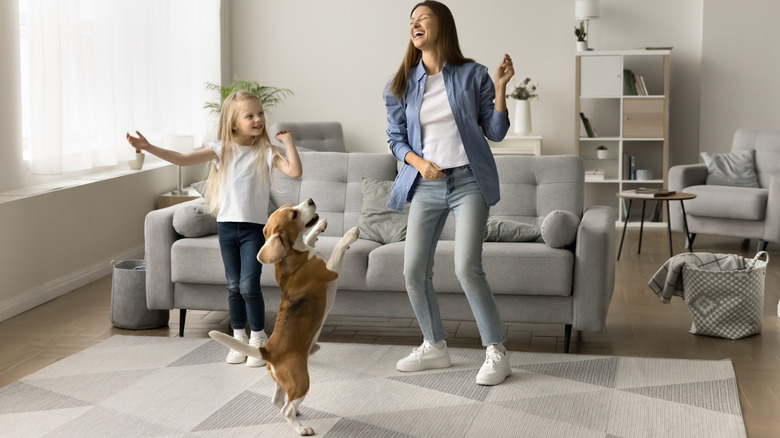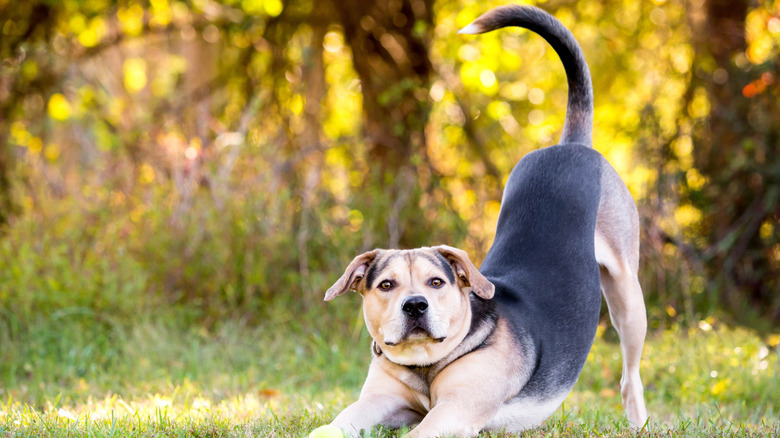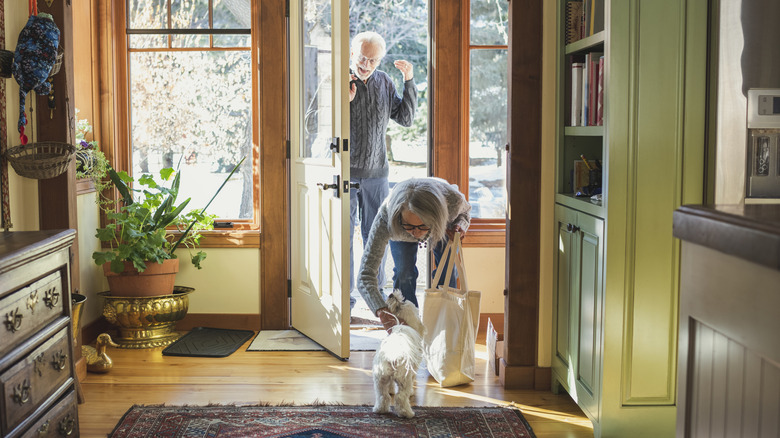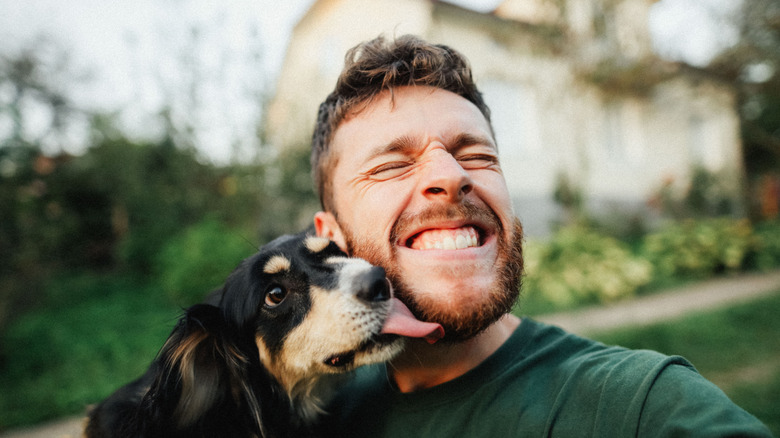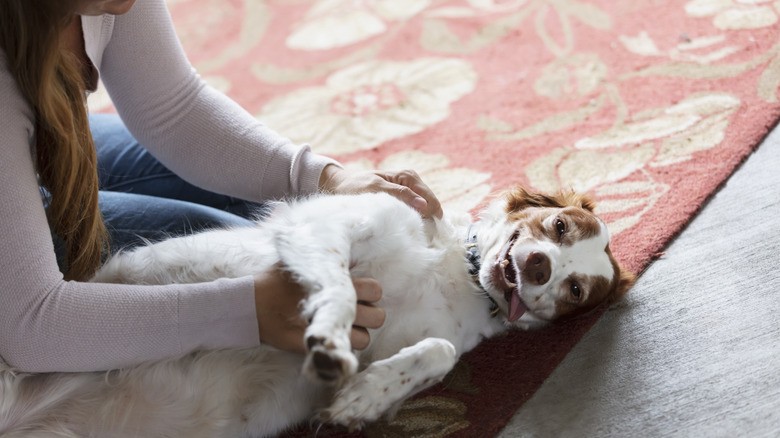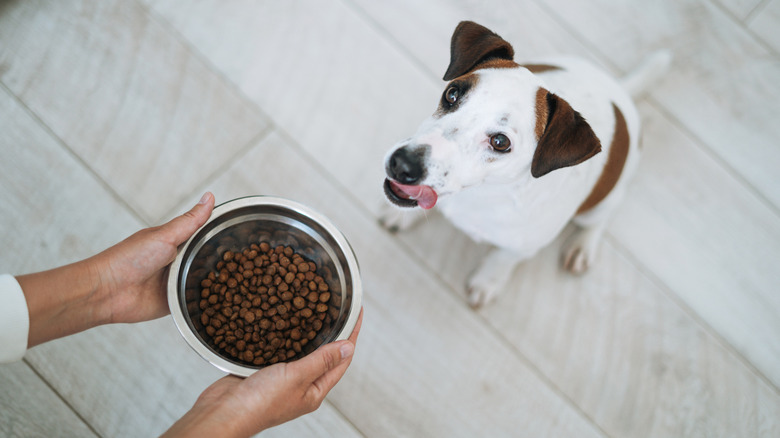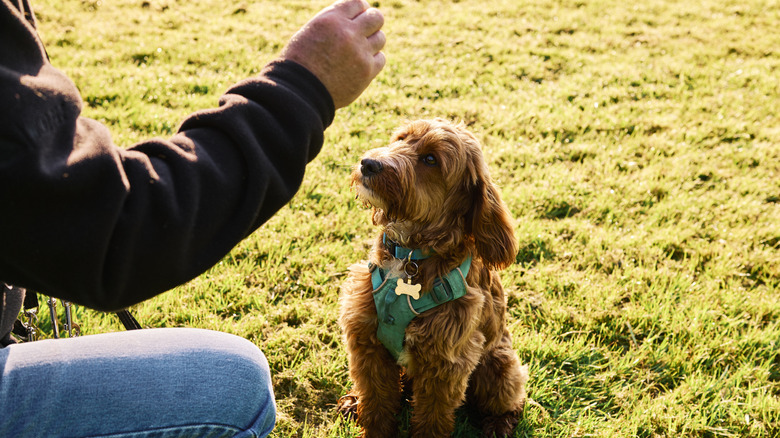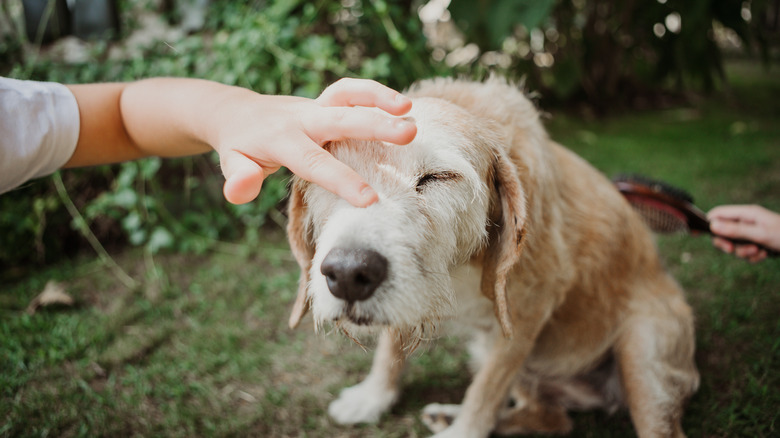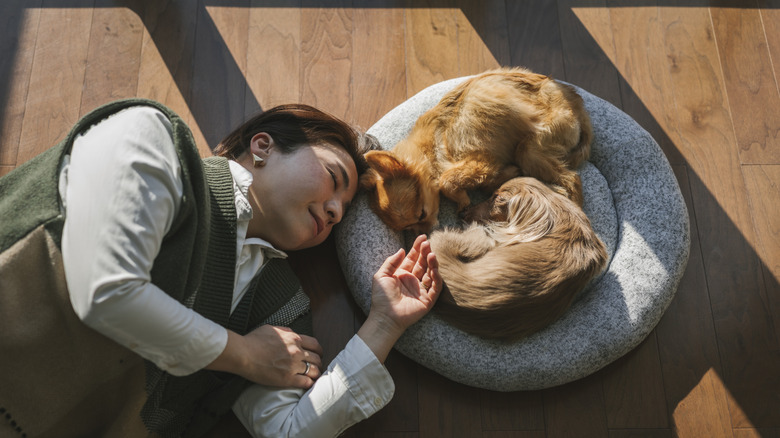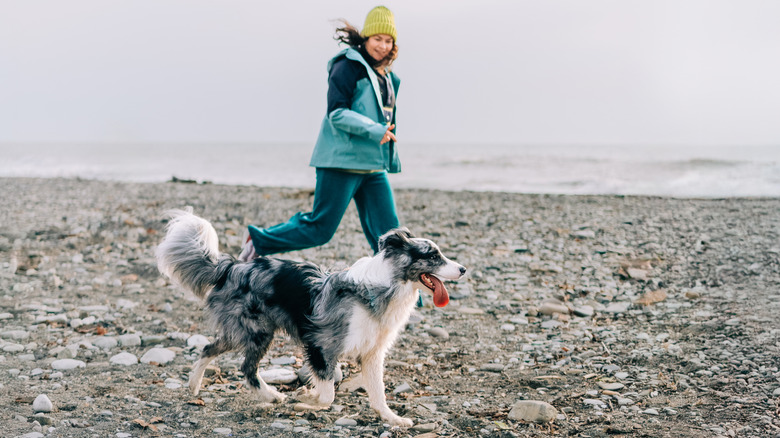Is Your Dog Happy? 15 Signs Of A Pleased Pup
It's obvious that your dog can make you happy. Research by the National Institutes of Health shows that interacting with a pet can reduce stress, improve your mood, and make you feel more social. Just looking at a little furry face can make you smile. But is your pup equally pleased? Dogs experience basic emotions like anger, fear, and happiness. Anger comes with snarls and bristling fur, fear causes timidity, and happiness expresses itself in tail wags and happy wiggles.
You know your dog better than anyone, and you're likely accustomed to planning meals and walks that promote physical health. Knowing how to interpret your dog's feelings helps you take care of their mental well-being, too. You can pay attention to what makes your dog happy and strengthen your bond while creating a home that works for the whole family, furry members included. A happy dog can spread delight in every room it enters, whether you're entertained by cheerful antics or warmed by the affection that happiness inspires.
Your dog shares its toys with you
Has your dog ever rushed over to you and plopped a toy on your lap or at your feet? Congratulations, you're living with a happy dog that loves you. That old stuffed animal or brightly colored squeaky ball may not mean much to you, but your dog's toys are its prized possessions. Only a happy and relaxed dog is willing to share something that's so important. Dogs that feel scared or uncertain about their surroundings might try to hide their toys or use them for comfort.
Dogs presenting toys to their humans is a common theme on the r/Dogs Reddit. One poster shared that when they're sick, their old English shepherd puppy "goes and gets it out of her crate and brings it to me. She has a ton of toys she loves, but she only brings out Snuggle Puppy when a human is feeling bad." It's as though the dog knows that the toys make her happy, and she wants those around her to feel the same way.
Your dog cuddles with you
Happy canines revel in human attention. They lap up your adoring looks and sweet murmurs, but often what they really long for is the moment when they can curl up in your arms. Cuddling is one of the purest expressions of love that you can share with an animal. You demonstrate that you trust each other, and you both experience a surge in oxytocin, a hormone associated with positive emotions.
While cuddling is usually the action of a contented pup, you should know that it isn't always the case. Sometimes, dogs need extra affection when they're feeling ill or a bit sad. To figure out why your dog is cozying up to you, pay attention to the rest of its behavior. Does your dog have unusually low energy or seem uninterested in its surroundings? Those are classic signs that something's wrong. Happy cuddling may involve more energy. Your dog might stretch itself across your legs while you scratch its ears, or nestle as close to you as possible.
Your dog has a relaxed, open-mouth smile
Your friends and family announce their glee with happy smiles. Sometimes, dogs do too! If you look at your dog's cute face and see a relaxed, open-mouth smile with curved lips or exposed teeth, there's a strong chance your pup is pleased at that moment. This gentle look is quite different from the teeth-baring, angry expression that you witness when dogs are feeling upset or defensive.
Canine smiles indicate happiness and love, but they're not exactly the same as human grins. Dogs may have started smiling because they realized that smiles made humans soften toward them and give them treats and praise. A pooch that knows how to read your body language may even smile back at you whenever your lips curl up in joy. You might also witness your dog smiling when they sense your anger and want to appease you. When submissive behavior causes the smile, expect to see more teeth and a lowered head and tail.
Your dog's tail wagging is a whole-body movement
Think about how your dog wags its tail. Does the tail move alone, or does your dog's entire body wag along with it? Dogs are physical creatures, and when they're feeling pumped, the excitement is sometimes expressed through their bodies. Tail-wagging that's more than just a wiggle happens when your dog is especially excited and gleeful. Perhaps you've been away for hours and your dog is finally seeing you again, or maybe you're holding a new toy or delicious snack.
Unlike some of the more ambiguous entries on this list, energetic, full-bodied tail wagging almost always signifies elation. Of course, dogs have individual quirks, and your furry friend may wag its tail in a milder way. That doesn't mean that your dog is unhappy or bored, though an apprehensive dog may wag their tail more slowly. Many merry pups only exhibit a few of the behaviors on this list. What matters is that you learn how your dog expresses joy.
Your dog can look into your eyes without stress
For your dog, eye contact is a big deal. A direct stare may be viewed as a threat, especially if you're looking at a dog you're not familiar with. When your own dog looks you in the eye, it's showing how much it trusts you. Your dog realizes that it doesn't have to be on its guard because you're a safe presence. This immense trust is built on happiness. Depressed dogs might stare at the floor instead and avoid your gaze.
By contrast, cheerful dogs may stare at you all the time and delightedly exchange direct eye contact. A dog that can focus on you enough to stare is one that's primed for training. Focused dogs take direction more easily and can learn to respond to signals. If your dog is too timid for eye contact, some pet owners posting in r/Dogtraining say that they've been able to help their dogs look them in the eye by connecting the action to treats, such as by teaching the "Look at me" command, which can help with trust and bonding.
Your dog breaks out into zoomies during moments of joy
Your dog can't join a dance team, but it may like to gleefully move its feet. Sometimes, dogs feel so overjoyed and eager for what comes next that they can't sit still. Instead, they enjoy a wild bout of movement. Researchers refer to these episodes as frenetic random activity periods (FRAPs), but most people call them the zoomies. Your dog may run frantically from room to room, jump on and off furniture, and tear into its toys.
Just watching the rapid activity may make you want to get involved, too. It's not necessary, however. Dogs can enjoy zoomies by themselves, with you, or with other trusted animals. A popular video on Facebook features a little girl in pink laughing as she watches a boxer with zoomies race from one side of the room to the other. To make sure that your dog's movements are the happy kind, look closely at its posture when it zooms by. If your dog looks tense, is hanging its head, or has its tail tucked between its legs, it may be exhibiting a fear or anxiety response rather than giddy zoomies.
Your dog occasionally takes a bow
You don't have to go to a theater to watch someone take a bow. Your dog may be perfectly willing as long as it's playtime! Happy dogs aren't afraid that you'll hurt them, so they'll adopt submissive positions during play. One example of this habit is the play bow. During a romp, your dog might lower its chest to the floor while raising its rear end to the ceiling (and you might even spot a wiggly, happy body, too). The resulting position looks exactly like a canine bow.
These play bows have nothing to do with deep respect or admiration. Instead, your dog's bow is an invitation to play. Your pup wants to tussle with you or perhaps chase you around the room. The play bow is another behavior that generally only pops up in happy dogs. Unhappy dogs may not want to play with others, while sick pups might not have the energy for it.
Your dog greets you at the door with excitement and energy
What happens when you get home from running errands? Do you open the door to find your dog already sitting there, tail wagging frantically and body quivering with excitement? A happy dog can't help but dance excitedly when confronted with its favorite humans. If you've had a bad day, or it has been a while since you saw your furry friend, the over-the-top greeting can make you feel like you're not alone in the world. You can easily go from driving home in traffic and feeling stressed about the day's events to melting at the overwhelming sweetness of your dog's hello.
Even better, your dog can have the same reaction every time you come home, no matter how often it happens. Actions that may become boring for you can have endless appeal for your dog. If your dog stays happy, you don't have to worry about the enthusiasm of your dog's greetings tapering due to anything besides age or illness.
Your dog loves to lick you
Pet parents posting on r/Dogs describe how much their dogs love to lick their faces and hands. One shared that "One of mine will only dole out a lick if she's especially happy or excited." Some say that their eager pups would spend all day licking them if it were possible. Your dog only needs to exhibit a mild interest for it to make sense for you to consider licking as a sign of happiness. There are a couple of reasons why a canine might lick a human, but happiness is the biggest. Dogs tend to amplify their good feelings by sharing them with others. When your dog licks you, you're sharing a special moment.
If you notice excessive licking to the point where you feel raw, it could potentially mean that your dog is experiencing anxiety rather than unadulterated happiness. Excessive licking can also be a symptom of medical conditions, such as allergies and flea infestations. These conditions cause the dog to lick itself repeatedly, and that action can carry over to you if you're near. However, if it's just a happy lick in the morning when you wake or come in the door, your pup is likely happy to see you.
Your dog rolls over and exposes its belly
It only takes one rough swipe of a claw to damage an exposed belly. That's why dogs only show their stomachs when they feel completely comfortable and content with their surroundings. When your dog does reveal its stomach, that's usually a prime opportunity to give it some belly rubs and have a mini-cuddle session, something both you and your dog can agree on helps promote relaxation and strengthens your bond.
Be careful, however. While most dogs love belly rubs, there are plenty who do not. There are dogs that trust you enough to show you their belly, but not enough to let you touch the area. There are also dogs that dislike the sensation of a belly rub. Regardless of whether you give belly rubs, if you're seeing your dog's exposed belly all of the time, you can feel pretty confident that you're living with a pleased pup.
Your dog has a healthy appetite
Dogs can struggle to eat for many reasons, but depression is a common cause. Unhappy dogs often show less interest in their meals, no matter what's being offered. Happy dogs behave in a very different way. Barring any medical or age-related issues, when your dog feels good about its environment, it will have a healthy appetite and eat well at mealtimes.
In fact, Dr. Joshua Smith, a veterinarian in Meridian, Idaho, told Newsweek that when your dog is in a good mood, it may perform a "contentment ceremony" after a meal. This will look different for every dog, but common displays of contentment include rolling on the floor and having dancing feet that constantly move. It's also normal if your full and happy dog would rather go to sleep after a big meal or snuggle up by your side. For some dogs, mealtimes are the most thrilling parts of the day, and they don't have the energy for a zany moment right after eating.
Your dog listens to your commands
A cheerful dog is one that's part of a pack. If your dog listens to your commands with no struggle, it signifies that the dog understands and enjoys its role. However, this is an appreciation that grows over time. If you adopt an untrained puppy, you may need to train the little fluffball for weeks or months before it starts gaining satisfaction from obedience.
Certain breeds are also more likely to enjoy training. For instance, German shepherds are typically highly trainable and happy to follow a command. Fluffy corgis can be stubborn and difficult to train. However, with a little patience, any dog can learn to work together with you. You can get a sense of how your dog feels by paying attention to its response speed after commands. A dog that leaps up to obey you, tail wagging, is having fun, while the dog that starts standing up but loses interest halfway either needs more training or has limited interest in obeying.
Your dog nudges you gently to ask for attention
Some dogs stare, some take a bow, and others gently nudge you with their noses when they want attention. There are so many different methods because getting your attention is one of your dog's primary goals, particularly when things are going well. In your dog's ideal world, you would spend most of your time hanging out together. When you're in the same room but are paying attention to something else, a soft nudge on your leg or arm can be enough to bring your gaze back to your pup.
A few pet parents posting about their Great Pyrenees on r/Greatpyrenees say that their dogs will keep nudging them until they physically get up. One shared, "My pyr will nose but my phone right out of my hand. [Or] if I'm looking at my phone he will put his nose under my hand to get my attention lol." Nudging behavior points to a contented pup, unless it's too persistent. If your dog grows demanding with its nudging, it could mean that it's bored or stressed.
Your dog gets plenty of sleep
Your dog's sleeping habits may give you a clue about its happiness. A healthy and contented adult dog will sleep about 10 to 16 hours a day on average. That's how much sleep your pup needs to function at its best. Dogs that get less than the recommended amount of sleep may become restless and easily stressed. They may even develop health issues, as sleep affects the immune system. All of these problems can make your dog seem less happy than usual.
When sleep is problem-free, dogs can flourish. They can devote all of their energy to getting through the day instead of struggling to fall asleep at night. An affectionate pup may decide to deepen its happiness by sleeping next to you and enjoying the sweet cuddles. On nights when your pup sleeps alone, you can gauge its happiness by looking at the clock. Your dog's 10 to 16 hours of sleep will typically be divided into two sections. Each one should be relatively calm. If your dog is tossing and turning, it could lead to stress.
Your dog enjoys exploring new places
Is your dog eager to explore new places on walks? A dog can only be confident and fearless when it's happy. A dog that's unsure of the people around it may be too timid to explore an unknown situation. A dog that's injured or ill may also feel cautious. Plunging into unexplored areas requires a willingness to face potential dangers. This doesn't mean you should place your brave canine in a legitimately dangerous situation. To your dog, just entering a new dog park can be a stressful experience.
If your dog avoids new places, it can still be a happy homebody. Exploring uncharted locations is a sign of happiness for outgoing dogs that are natural adventurers. A calm, tiny lap dog might get enough excitement at home. In this case, exploring new places might turn into experimenting with fresh toys and games. Here, too, you can see the signs of happiness.
